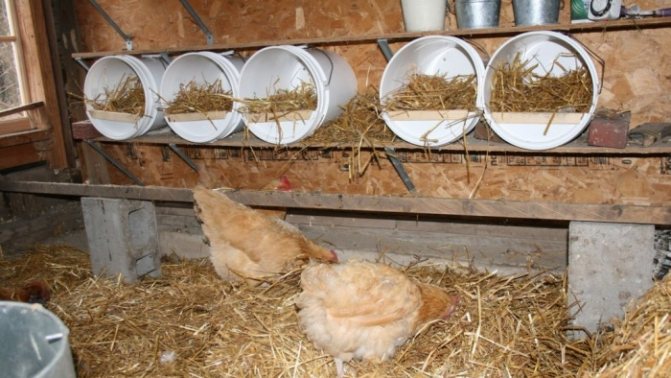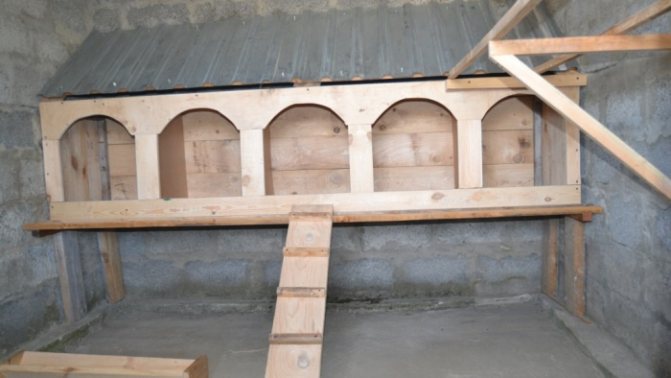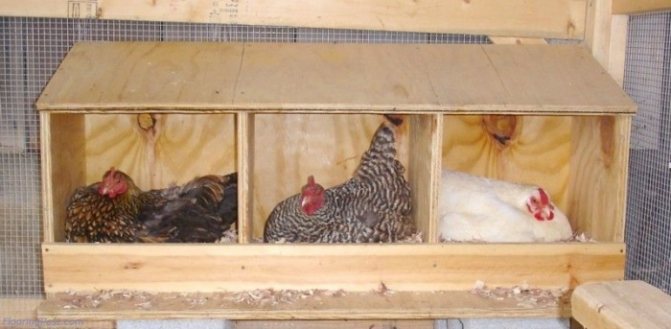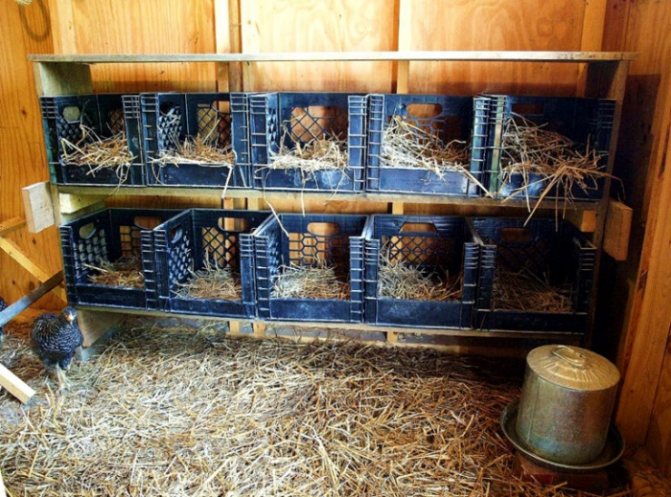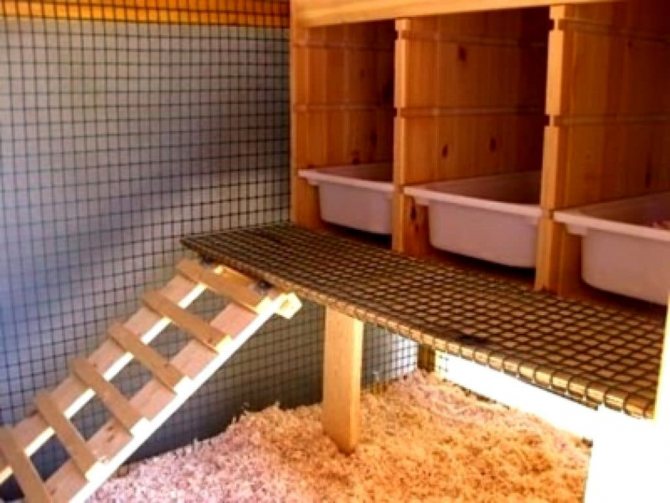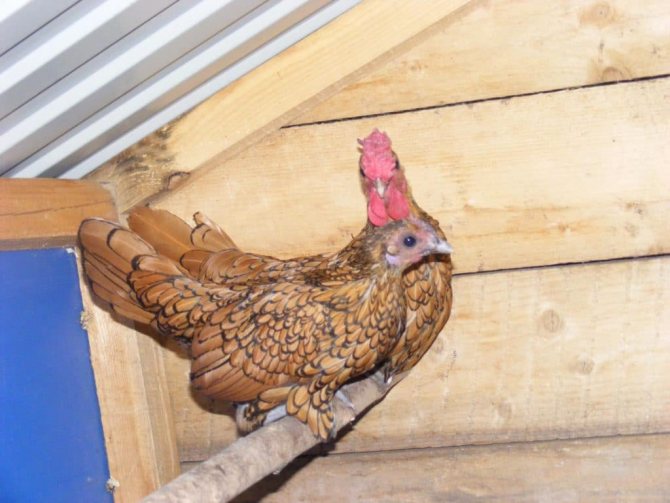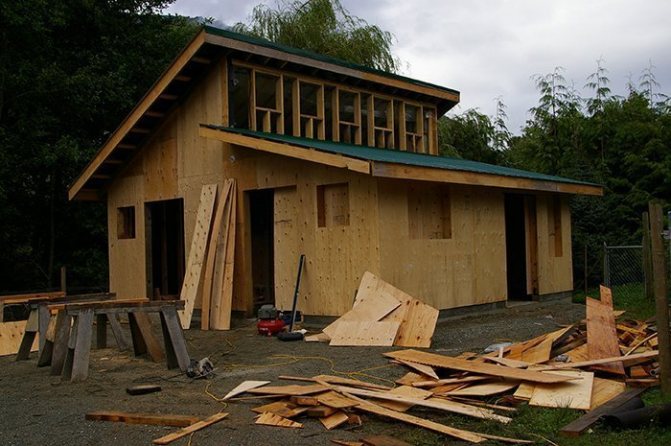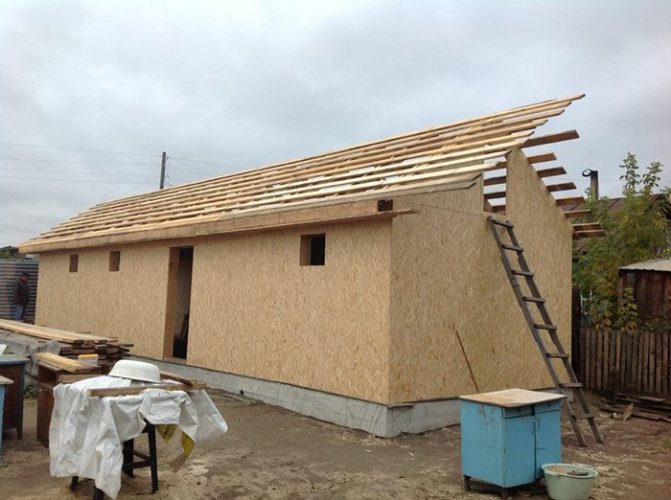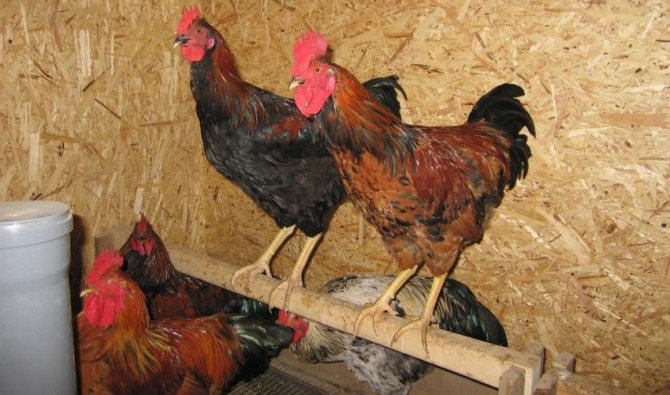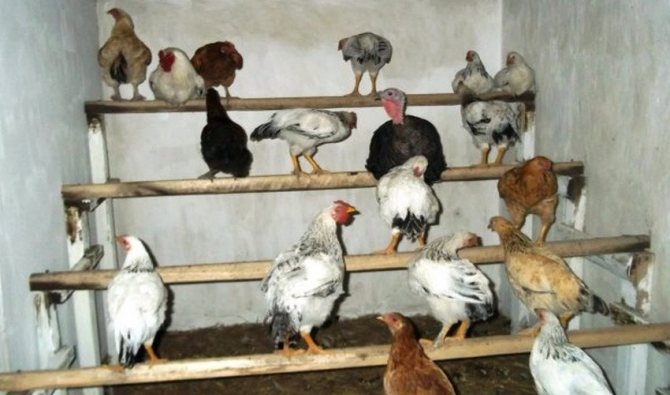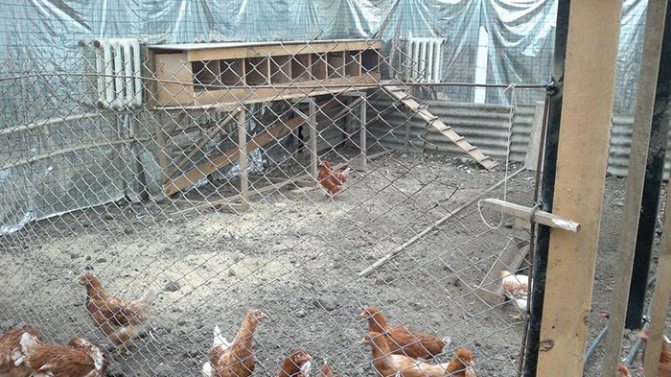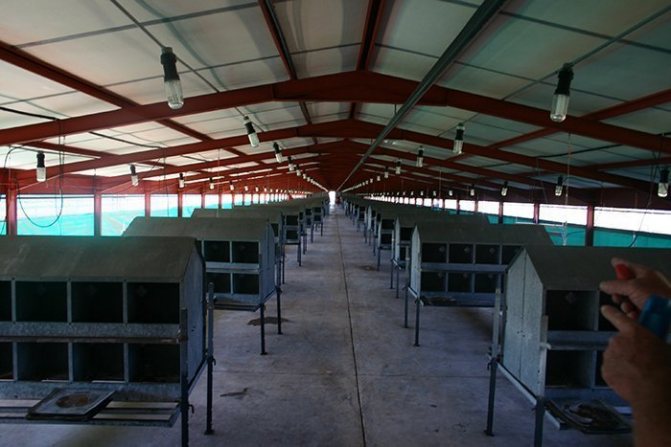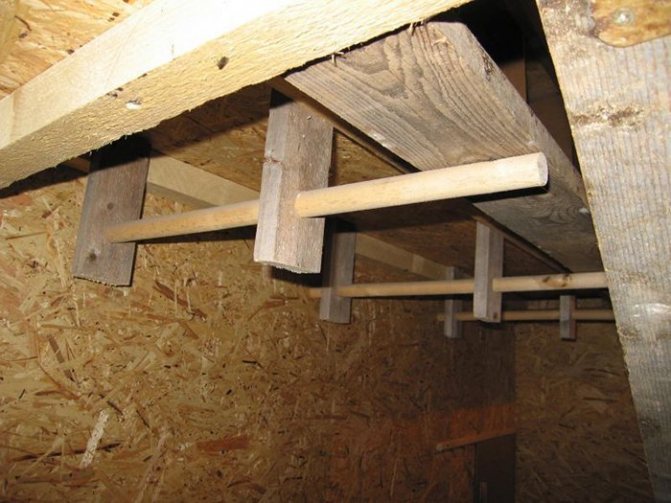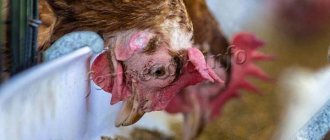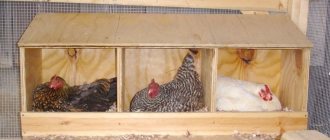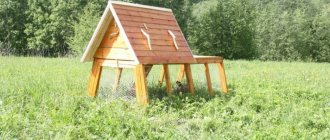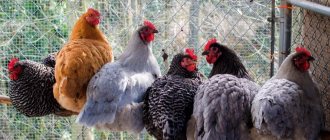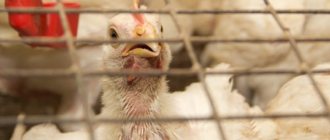What is a roost for?
A perch is called a perch for placing birds, which is necessary for good sleep and rest.
This structure performs a number of important functions:
- rest and sleep of adult birds, close to natural conditions;
- reducing the likelihood of contracting viral or fungal infections living in dirty litter;
- ensuring the safety of birds: protects against weasel and rat attacks;
- prevention of frostbite of chicken paws in winter;
- allows chickens to stay clean and not touch their droppings.
Why do chickens need a roost, and what role does it play
Domestic chickens, like their ancestors or wild chickens, prefer to sit not on the ground, but on branches or fences. In an ordinary chicken coop, this role is played by roosts. It is convenient for the bird to rest on them, as well as sleep at night.
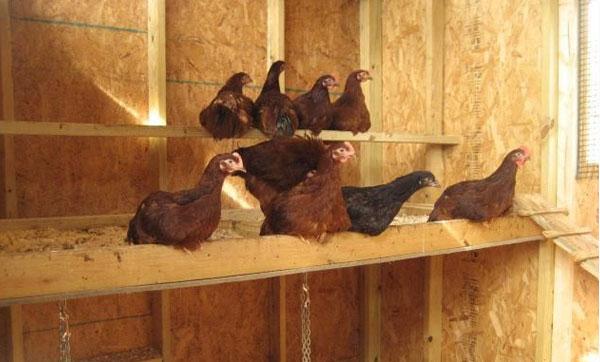
Roosts for chickens perform another function - being not on the ground, the bird is much less at risk of contracting fungal or viral diseases, the pathogens of which can be found in dirty or damp litter.
Primary requirements
When making a place for rest and sleep for chickens with their own hands, one must take into account the physiology, number and breed of birds.
The basic rule when arranging a perch is the free and easy placement of birds on it; they should not disturb each other while moving. Feet should grip the pole lightly. Laying hens will rest and sleep on this device, so all adult livestock should fit on it.
For the convenience of birds, it is recommended to place the finished structure in a warm, well-lit or illuminated place at night and protected from drafts, away from window and door openings. This way they will feel more secure.
Length
The length of the device depends on the number of inhabitants of the hen house. It is generally accepted that 18-25 cm of perch is enough for one laying hen, depending on the breed. But if there is an opportunity, it is preferable to make the bars more authentic - in crowded conditions, the chickens begin to fight and discard smaller layers.
It should be noted that an overly long bar is undesirable - without additional supports, it will bend under the weight of chickens.
The ideal roost length is no more than three meters, with one or more additional supports.
Diameter


It is very important to correctly determine the size of the roost bar.
To build a roost of a suitable diameter, it is necessary to recall the structure of a bird's paw: three fingers in it are directed forward, and one is in the opposite direction. Sitting on a branch, the birds bend their legs at the knee joints, the tendons are stretched, and the muscles contract. They grasp it tightly with their fingers and cling to the wood with their claws, which allows them to hold on tightly and not fall even during sleep.
It is not allowed to use shelves, boards, thin sticks and thick logs that the bird is not able to grasp with its paws - they will be very uncomfortable on them.
The ideal perch is a 40 x 60 or 50 x 50 mm bar with rounded and well-rounded edges. To prevent injury to the chicken's paws, the tree should be well sanded.
Experienced poultry farmers recommend using a block that is half the length of the chicken's open paw or the distance from the thumb to the beginning of the middle toe.
Height
Height is an equally important criterion.
For small-sized hens, it is 60–80 cm, for large birds - at least 80 cm.
Sitting on the roost, the birds make a jump and fly up a little, which serves as a small warm-up for them. But layers should not experience any difficulties, therefore, the height of the structure is not allowed to exceed more than one meter.
For the convenience of chickens, poultry farmers are advised to build a small staircase, along which they can climb without causing inconvenience to their neighbors.
Table: the main parameters of the perch for different breeds of layers
| The size birds | Small | Average | Large |
| Height from the floor, cm | 60 to 80 | 70 to 90 | 80 to 110 |
| Distance to the wall, cm | 25 to 35 | 35 to 45 | 45 to 55 |
| Vertical distance between tiers, cm | 30 to 35 | 40 to 45 | 45 to 50 |
| Horizontal distance between tiers, cm | 35 to 40 | 45 to 50 | 50 to 55 |
| Distance from floor to pallet, cm | 35 to 45 | 40 to 50 | 50 to 60 |
Layer nest requirements
The place for laying eggs is a very important element of the chicken coop. It should be comfortable and comfortable so that the chicken does not refuse to lay eggs in it. The nest should be solid, without protruding nails or sharp chips. It should also be easy to clean and disinfect.
There are two variants of the nest - with and without a roof. It is recommended to give preference to the first option. In an open container, eggs are stained with droppings, since chickens love to sit on the edge of the box.
You can use wooden boxes, boxes or wicker baskets as a nest. However, this will only work for a small number of chickens. It is often difficult to find a large number of containers that match the size. With a large population, the ideal solution would be to make nests with your own hands.
Valentina Kravchenko, expert
Optimal dimensions
The optimal size of the nest for an egg-hen in width, depth and height is 25x35x35 cm, and for a meat-and-meat breed - 30x40x45 cm. With a large number of layers, it is recommended to arrange the chicken "workplaces" in the form of a stack, forming two or three tiers. The lower tier should be approximately 30 cm from the floor.
At the entrance, a sill with a height of at least 5 cm must be erected, and a shelf for take-off is installed directly in front of the nest. Above the upper tier, it is advisable to build a roof at an angle of 45 ° so that the chicken does not have the desire to sit on it.
Filler height is another important parameter to consider. You should not fill the nest to the top with sawdust, otherwise the eggs will roll out to the floor. The filler layer should be 5 cm below the edge.
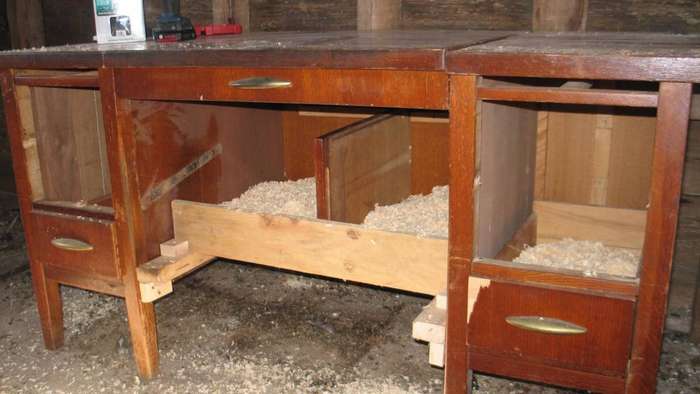

What to make a chicken nest
Places for laying eggs are made from natural materials. This can be plywood, wood planks, or some other safe material. Straw, hay or sawdust (pine or oak) are used as bedding for the nest. Experienced farmers are advised to give preference to sawdust. Laying hens, perching on a clutch of eggs, will not be able to push the sawdust out due to their large mass.
Placing nests in a chicken coop
Before starting to build nests, you should think carefully about their placement in the chicken coop. There are several important requirements for the place where eggs are laid:
- The nests should be in a dry place. High humidity can cause colds in laying hens and a decrease in their egg production.
- Do not place egg laying places near the entrance in a draft, which can make the bird sick.
- The jacks should not be prominently displayed. It is advisable to choose a secluded darkened corner for them.
- You should not place nests on the ground, otherwise layers will suffer from cold and dampness. The ideal placement height is 30 cm from the floor.
When placing nests, their number should be correctly calculated. As a rule, there are 5 layers per place. If you have 20 chickens on your farm, then you will need 4 “jobs” for layers.
Nests should be made before the chickens enter the house, so that before the first laying of eggs, the laying hens have time to get used to and get used to a permanent place. When thinking about placement, you can sketch out a rough drawing of the chicken coop, which will show where and what needs to be placed.


Location
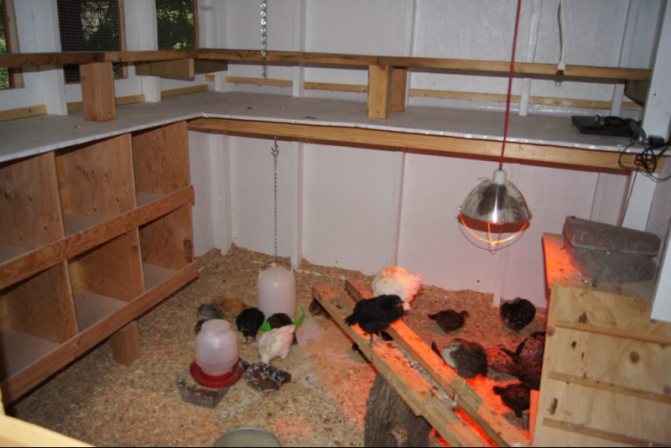

The bird roost should be located in the most secluded place of the chicken coop
By their nature, chickens are very shy. Therefore, to provide them with full rest and comfort, it is necessary to exclude loud sounds, cold air and drafts.
Usually, a device for rest and sleep is located at the farthest and most deaf wall, as far as possible from door and window openings. In such secluded places, the bird will feel completely safe. The floor underneath should be free of crevices, with a good and clean bedding.
With a large number of chickens, it is preferable to make multi-row perches. In these cases, the distance between adjacent rows should be at least 35 cm for small ones, and about 50 cm for large individuals.
For more convenient cleaning, it is preferable to make a multi-row structure reclining. The best option is to build a special pallet under it for droppings made of tin, plastic or waterproof OSB sheets, which is placed 40 cm above the floor and 30 cm below the perches for sitting birds.
Perches should not be located above feeders or drinkers.
At what height to do and where to place in the chicken coop
Many owners are wondering where to place the perch so that it becomes a place of good rest for living creatures. Under natural conditions, birds climb high tree branches for the night to hide from a predator.


Accordingly, at the level of instinct, chickens will strive to find a higher place to sleep, the owner's task is to choose a structure of the desired height. It will be different for each breed. On average, this figure is from 60 cm to a meter. (For more information on the height of the beams for different breeds, see the table.)
The roost in the hen house should be set up in a secluded place so that the bird feels safe. It can become a darkened part of the room, away from windows and doors, so the sleeping place for layers will be protected from bright light and drafts.
Did you know? Chickens lay eggs mainly during the daytime. The main condition is the presence of light, and its origin does not matter (artificial lighting can serve as an alternative to natural).
Views
There are many different variations of the improvement of chicken coops, and each of them is functional and convenient in a special way. The choice of the type of perch depends on the following factors:
- the size and layout of the chicken coop;
- the number of birds;
- the appropriateness of the design.
Bird breeders distinguish the following types of perches:
- Single-tiered.
- Multi-tiered.
- Angular.
- Portable.
- Lifting.
Single-tiered


Single-tiered bird roost
This option is the simplest design for resting hens. It is usually placed along one or more walls, at a distance of 40 cm from the wall and 60 cm from the floor. For its manufacture, the prepared bars are fixed between the walls, laying them on supports made of boards with grooves, this will prevent the bar from turning over or shifting. The pallet under such a device can be omitted, because it is very easy to clean under it.
Experienced poultry farmers do not recommend equipping his ladder or ladder, as many do, since layers must always be in good physical shape.
Benefits:
- easy to clean under it;
- simple and easy to manufacture;
- reduces fights between chickens.
Disadvantages:
- suitable only for a small number of chickens.
Multi-tiered


Multi-tiered chicken roost
This option is traditional. This design significantly saves the space of the chicken coop. In its structure, it is similar to a single-tier roost, but in it the beams are attached in several rows, one above the other, the distance between which is at least 50 cm. Otherwise, the droppings of chickens that sit higher will stain those sitting below.
For such a perch, a frame is first installed, to which prepared beams are attached. The poles can be placed against one wall or around the perimeter of the house.
The location of the structure can be different: in large farms, these are multi-tiered beams from floor to ceiling, and 2-3 long poles are enough for novice farmers. Sleeping and resting areas can be located in a separate room or combined with nests for layers.
Benefits:
- saving poultry house area;
- easy to manufacture.
Disadvantages:
- constant competition: larger and stronger birds occupy the upper places, and small and weaker ones - in the lower tiers;
- unhygienic: the upper birds can relieve themselves on the lower ones;
- constant cleaning is necessary.
Angular


Corner multi-tiered perch for layers
A corner place for chickens to sleep and rest is ideal for owners of a small number of individuals. It can consist of one or more tiers. For its manufacture, the beams prepared in advance are placed by surprise between adjacent walls.
Benefits:
- saving space in the chicken coop - perches can be placed in all four corners of the room;
- lightweight and simple to perform;
- the possibility of placing in a quiet corner of the barn, where nothing can disturb the birds.
Disadvantages:
- suitable only for a small number of chickens - up to 20;
- impossibility of thorough cleaning with a multi-tiered structure.
The problem of inconvenient cleaning under a multi-tiered corner perch can be solved by making the lower rails of the structure removable.
Portable
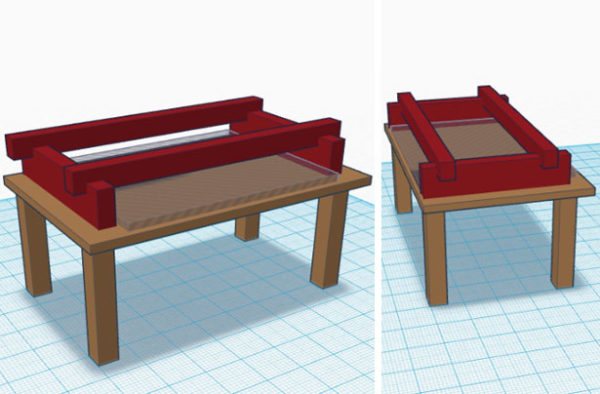

Portable bird roost
Most often they look like a table equipped with a tray that serves to collect chicken droppings. There are several rows of bars above it. Such structures are also called "hygienic perches".
Portable roosts are ideal for temporary bird housing, such as in a summer barn.
When creating a portable place for sleeping and resting birds, you need to take into account the fact that it will have to be repeatedly moved from one place to another or to the street, so it must freely pass through the doorway.
Such a structure consists of 4 supports made of deciduous beams or a wooden board 20 mm thick, which are connected along the perimeter with 2-3 crossbars in a pair of rows. On the lower ones there is a support for the droppings, on the upper ones - poles for laying hens. In the multi-row version of the portable roost, the beams are located at an angle of 50-60 degrees.
An important point in the manufacture of such devices is to equip the pallet with sides at least 8 cm high so that the droppings and sawdust do not fall out of it. Clean sawdust should be added daily, and when they become wet, mix with lime. Sanding the edges of the pallet is obligatory.
This roost will come in handy in the following situations:
- Temporary placement of birds: in the summer in the barn, and in the winter - in the hen house, or for the period of repair in the hen house.
- To train hens to perch: it is small in size, and the chicken sits on it with pleasure.
- For farmers: in such structures it is very easy and convenient to clean up, and the collected manure can be adapted to fertilize the soil.
Benefits:
- this species is considered the most hygienic place for chickens, it is easy and quick to clean in it;
- takes up little space in the room;
- such a design is easily transferred from one room to another;
- helps to train the bird to roost;
- suitable for a large number of layers.
Disadvantages:
- requires more time, money and skill to craft than others.
Lifting


Drawing of a lifting roost for chickens
This variation of the place for sleeping and resting for laying hens differs from the rest in that the bars are attached with loops in it. This design contributes to the most convenient and fast cleaning in the poultry house.
With pallet
Many farmers use standard plastic pallet perches. In fact, this structure is somewhat similar to the construction of simple poles, however, the very pallet is located at the bottom of the structure.
It is worth noting that the droppings do not need to be thrown away. It is used as a fertilizer in the garden and is even sold.
To make such a roost, you need to perform a number of actions:
- First of all, bars are placed at a distance of ninety centimeters from the floor, which will serve as supports.
- Then, using a plane and sandpaper, the wood should be processed so that the chickens are not injured.
- Next, step back thirty centimeters from the wall and nail a few beams to the base.
- On the sides we attach blocks, the height of which is forty centimeters, then fix the pallet.
- Any metal or plastic container can be used as a pallet. Wood should not be used, it absorbs all substances well, it is difficult to wash it.
- Finally, using wood, a ladder is made and leaned against the main perch.


How to make a roost for chickens with your own hands: step by step instructions
The methods of erecting all types of perches for layers practically do not differ from one another. To do this, you will need the following tools and materials:
- wooden beams;
- saw;
- sandpaper;
- plane;
- nails;
- a hammer.
Making a roost
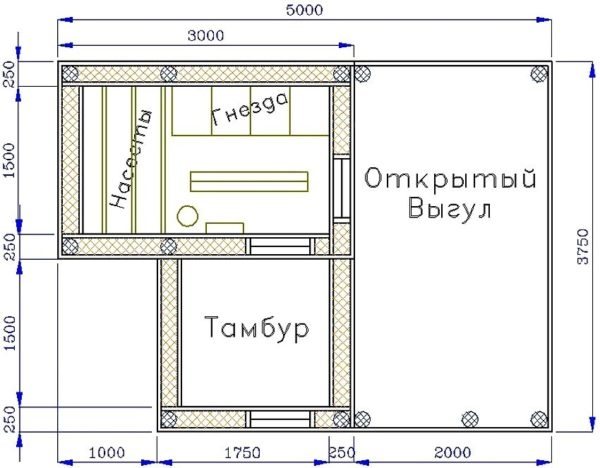

Chicken coop arrangement scheme
Step-by-step instruction:
- Determine the size of the house, the location of doors, windows, doors for walking birds. For greater comfort, it is recommended to draw a drawing of the house with all measurements, as in the above figure. On the diagram, it is necessary to mark the location of nests, drinkers and feeders, containers with feeding, boxes with sand and ash for bathing.
- Choose a suitable type of perch. They mark it on their drawing, checking if it is in a draft and if it will interfere with cleaning the house, collecting eggs and feeding the chickens. The width of the passages between all objects in the room should be at least 50-60 cm.
- They process a wooden block. Deciduous wood species such as birch are preferred. They are distinguished by their high density, do not bend under the weight of the chicken and do not emit tar. Conifers can also be used, but because of the greater flexibility, 40 x 60 mm beams must be chosen.
- The bars are cut to size. The upper edge is made more rounded with a knife or plane, the bar is cleaned by hand or with a grinder.
- Coniferous wood should be scorched with a blowtorch. This procedure will eliminate resin build-up and material decay.
- For the manufacture of a fixed perch, attached to the wall, supports with grooves are constructed from pieces of board. Their size should be 2-3 mm larger than the diameter of the prepared bar. At the same time, it should enter the grooves without obstacles, but not hang out in them.
- Supports are fixed to wooden walls with nails, and to brick or block walls - with dowels and screws. It is recommended to use a bubble level to position the structure horizontally.
- The bars prepared in advance are placed in the grooves and tested for deflection. If necessary, make additional supports.
For multi-tiered perches, it is advisable to build a litter tray.For this purpose, according to the described scheme, several parallel bars are installed at a distance of 30-40 cm from the floor, a sheet of plywood or tin is applied to them. For greater convenience, poultry farmers recommend not fixing it on a support, but making it removable. The edges of the pallet should extend beyond the perch in front by 20 cm, and at the back - to reach the wall.
If desired, the device is equipped with a ladder or ladder with an angle of inclination of about 60 degrees and a distance between adjacent rungs of at least 20 cm. The hen will be able to climb upward without difficulty, and it will not take up much space.
A portable roost is a structure consisting of four supports made of a bar or board with a thickness of at least 20 mm, which are connected along the perimeter by two rows of crossbeams. On the lower ones, located 40 cm above the floor, there will be a tray for collecting manure, on the upper ones - perch runners. In the upper crossbars, grooves are made for laying the beams. For the manufacture of a multi-tiered portable perch, the upper crossbeams from the ends are placed at an angle of 45-60 degrees.
Removable litter trays
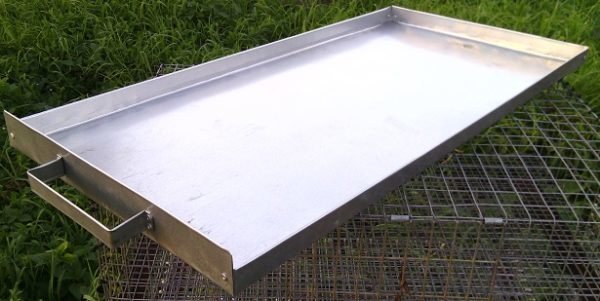

Tin tray for collecting droppings
Very often, portable and multi-tiered sleeping and resting places are equipped with removable pallets to facilitate cleaning. Robust and stainless steel pallets can be made of galvanized sheet. Their size always depends on the parameters of the place for bird rest and sleep.
The width should not exceed 50-60 cm, otherwise it will not be rigid enough, and the length is determined by the width of the perch: for single-row structures - 60-70 cm, for multi-row or multi-tiered structures - 60-120 cm.
For greater practicality, the pallet is equipped with sides about 5–8 cm high, which increase its rigidity and prevent sawdust and droppings from falling. From the side of the wall, the side is made at a slight angle. This makes it easier to remove dirty litter. On the other sides, the sides should be vertical so that they can be placed point-blank against each other.
Pallet manufacturing consists of the following steps:
- A drawing of the future pallet is prepared with a size designation: a rectangle is drawn with the parameters of the pallet, an increase of 5-10 cm is made on three sides for bending the sides.
- With the help of a marker, ruler and square, markings are made on a sheet of tin.
- With a grinder or jigsaw, the shape of the future pallet is cut out of the tin.
- Tuck the edges in the form of sides, using a piece of board and a wooden mallet for this. The front edge should be made tighter by folding the metal around a 20 x 40 mm piece of wood. It will be more convenient to take it with your hands during cleaning, this will prevent injury to the chicken paw.
- The edges are cleaned with a grinder with a grinding wheel. This will prevent injury and cuts during operation.
The finished pallets are placed on the prepared flooring under the perch and covered with filler: wood shavings or a thick layer of sawdust. A fresh layer of filler is added daily, and when moisture and unpleasant odors arise, it is mixed with dry lime. The described activities contribute to the disinfection of the litter. Cleaning is carried out as soon as the pallets get dirty and fill, but not more often than once every 7-10 days.
Arrangement of a chicken coop: perches, nests, drinkers
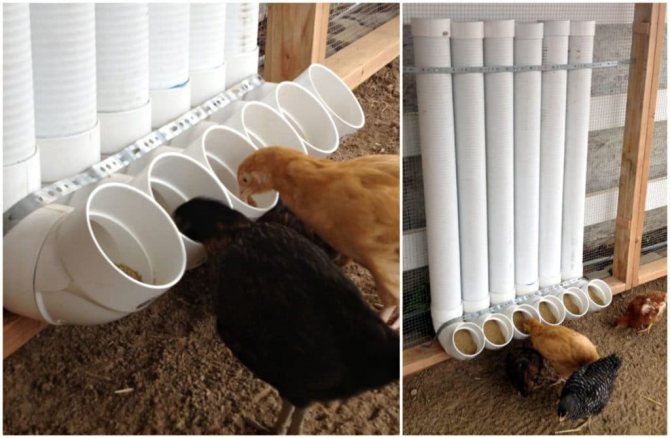

Homemade chicken feeder
In addition to creating comfortable conditions for birds, proper arrangement of the chicken coop is necessary for ease of maintenance. The interior of the chicken coop includes perches, nests, feeders and drinkers. With the correct arrangement of the house, perches should be located at least 60-90 cm from the floor (but not more than 1 meter) and 24 cm from the walls. They should be placed opposite the nests.
Nests are where chickens will incubate their eggs. At the same time, all birds do not rush, so the number should be 1 nest for 3-5 chickens, for oviparous breeds this number can be doubled. They need to be placed so that nothing distracts the chicken from hatching eggs.Therefore, they need to be placed in the darkest and most secluded place, at a height of 40-50 cm from the floor. Chickens will lay well in soft, fairly spacious nests with bedding. Their width should be 40 cm, height - at least 35 cm. Hand-made, gentle stairs will help chickens easily get to the nests.
The location of the feeders and drinkers should be at a distance of 20 cm from the floor so that birds do not climb into them with their feet. These can be wooden or plastic containers, with rounded edges to prevent scattering of feed. It is most convenient to place drinkers and feeders near the wall between perches and nests, in the visibility zone of the maximum number of chickens. Drinking bowls and feeders can also be hung on the wall by equipping them with ladders. The photo below shows modern plastic bird drinkers.
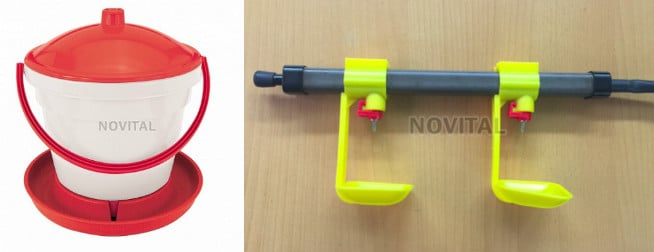

Modern types of drinking bowls for chickens
Roosting chickens
Quite often, poultry farmers are faced with the fact that chickens do not want to sit on prepared places for rest and sleep. To solve this problem, it is necessary to pick up the laying hen every evening and plant it on a new perch. Such "persuasion" usually takes about 10 days, sometimes up to a month.
It is necessary to be persistent and not to miss a single day. Gradually, some of the birds will get used to it and begin to jump on their own to a new berth, and the rest will follow them.
If the described technique does not help, it means that an error was made in the manufacture of the structure. You also need to reconsider its placement. The perch may be too high or in a draft.
The roosts, made in accordance with all the rules, will allow the hens to fully rest and feel completely safe. This will lead to an increase in the immunity of birds, an increase in the number of eggs and their life expectancy.
There are a great many ways to make a perch for laying hens, so every chicken breeder will be able to choose the most suitable option for his farm.

